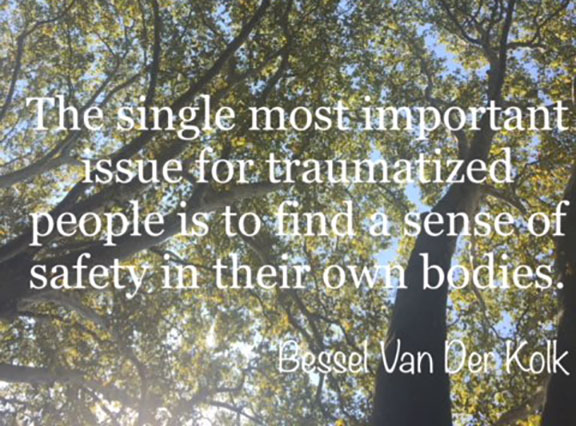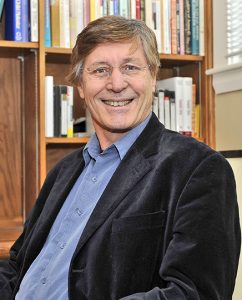 Dr. Bessel van der Kolk is considered one of the world’s leading authorities on Post-Traumatic Stress Disorder (PTSD). He has pioneered the use of Yoga as a therapy that is helping these individuals to work through their PTSD and regain a sense of mastery that has been absent since the trauma occurred. In this interview he discusses mind-body connections in trauma, how Yoga works and precautions for teaching trauma-sensitive Yoga students.
Dr. Bessel van der Kolk is considered one of the world’s leading authorities on Post-Traumatic Stress Disorder (PTSD). He has pioneered the use of Yoga as a therapy that is helping these individuals to work through their PTSD and regain a sense of mastery that has been absent since the trauma occurred. In this interview he discusses mind-body connections in trauma, how Yoga works and precautions for teaching trauma-sensitive Yoga students.
Integral Yoga Magazine (IYM): How did you get interested in Yoga for the treatment of PTSD?
Bessel van der Kolk (BvdK): I began my own practice some years ago. I was looking for a way for people to regulate the core arousal system in the brain and feel safe inside their bodies. My interest came from doing research that discovered how trauma affects the brain. I was looking for a way people could befriend their bodies and feel safe inside their own skins. Yoga turned out to be a way to get people to safely feel their physical sensations and to develop a quiet practice of stillness.
Lots of Yoga sites claimed that Yoga could change basic brain functions, but that was based on intuition, not scientific investigation. So, I decided to see if Yoga can positively affect the core regulatory mechanism in the brain. As we developed our Yoga program it turned that Yoga is great for most people, but some trauma-sensitive people can feel frightfully unsafe experiencing the sensations that are evoked by certain asanas. What most people do not realize is that trauma is not the story of something awful that happened in the past, but the residue of imprints left behind in people’s sensory and hormonal systems. Traumatized people often are terrified of the sensations in their own bodies. Most trauma-sensitive people need some form of body-oriented psychotherapy or bodywork like Tai Chi, Rolfing or craniosacral therapy in order to regain a sense of safety in their bodies.
IYM: How does exposure to extreme stress affect brain function?
BvdK: Neuroimaging studies of human beings in highly emotional states reveal that intense emotions, such as anger, fear or sadness, cause increased activity in brain regions related to fear and self-preservation and reduced activity in the brain regions related to the ability to feel fully present.
People with PTSD lose their way in the world. Their bodies continue to live in an internal environment of the trauma. We all are biologically and neurologically programmed to deal with emergencies, but time stops in people who suffer from PTSD. That makes it hard to take pleasure in the present because the body keeps replaying the past. If you practice Yoga and can develop a body that is strong and feels comfortable, this can contribute substantially to help you to come into the here and now rather than staying stuck in the past.
IYM: What is the main challenge for people who are trauma sensitive?
BvdK: The challenge is to learn how to tolerate feelings and sensations by increasing the capacity for interoception or sitting with yourself, noticing what’s going on inside. This is also the basic principle of meditation. They need to learn how to modulate arousal. Trauma-sensitive people have their sense of time thrown off. They think something will last forever. Their challenge is to learn how to notice what is happening and how things can and will shift, rather than jumping up and running away or turning to alcohol or drugs to self-medicate.
IYM: You have said that people with PTSD, who have chronically overwhelming emotions, lose their capacity to use emotions as guides for effective action.
BvdK: The function of emotion is e-motion, to engage in action. If you are afraid, you want to move away from the object of fear. If you become angry, that emotion makes you feel as if you want to engage or get physical with whomever is making you angry. If you love someone, naturally you want to make some movement toward that person. That is the purpose of emotion—to propel us toward action. When you are traumatized your motion is paralyzed. A victim of violence—as in the case of a rape victim for example— almost invariably has been trapped, pinned down or unable to move. What happens later is that, if there is a perceived threat, the body reacts as if it has to move but it once again feels helpless and paralyzed, prevented from being able to act effectively. All the chemicals are released to engage in action but the body doesn’t know how to move. Their challenge is that after confrontation with physical helplessness, it is essential to engage in taking effective action.
IYM: Are those who are trauma sensitive particularly challenged when it comes to self-care?
BvdK: The rational brain is the crowning glory of human beings. It is there to help us to engage in the world, but it is not very good in helping us take care of ourselves. In other words, the rational mind, while able to organize feelings and impulses, is not well equipped to abolish emotions, thoughts and impulses. People with PTSD, usually are out of touch with their physical sensations, and, as a consequence, they have trouble taking care of themselves. On the other end of the brain, the reptilian part is not good in quieting and taking care of the mind. However, when that system is harnessed the mind gets clearer, it’s easier to regain perspective on one’s life. It is surprising that, in contrast to Asian and African cultures, western traditions hardly pay any attention to the cultivation of techniques to quiet ourselves—we have been urged to “better living through chemistry.”
IYM: Have Western psychotherapies failed to address this?
BvdK: Western psychotherapy has hardly paid any attention to the experience and interpretation of disturbed physical sensations and action patterns. Yoga is one of the Asian traditions that clearly help reintegrate body and mind. For someone to heal from PTSD, one must learn how to control bodily reflexes. PTSD causes memory to be stored at a sensory level—in the body. Yoga offers a way to reprogram automatic physical responses. Mindfulness, learning to become a careful observer of the ebb and flow of internal experience, and noticing whatever thoughts, feelings, body sensations and impulses emerge are important components in healing PTSD.
IYM: How does Yoga do that?
BvdK: Yoga helps a person to regulate their emotional and physiological states. It allows the body to regain its natural vs. frozen or paralyzed movement. It also teaches people to use the breath for self-regulation. What is beautiful about Yoga is that it teaches us—and this is a critical point for trauma-sensitive people who feel trapped in their memory sensations—that things come to an end. While doing certain asanas, uncomfortable sensations are often evoked. But, by keeping time as one stays in a posture for a limited amount of time, the Yoga practitioners get to observe that discomfort can be tolerated until one shifts into a different posture. The process of being in a safe space and staying with whatever sensations emerge and seeing how they come to an end is a positive imprinting process. Yoga helps them to befriend their own bodies that have betrayed them in their failure to guarantee safety.
Another important aspect of Yoga is utilizing the breath. It’s very striking that there’s nothing in western culture that teaches us that we can learn to master our own physiology— solutions always come from outside, starting with relationships, and if those fail, alcohol or drugs. Yoga teaches us that there are things we can do to change our brainstem arousal system, our sympathetic and parasympathetic nervous systems and to quiet the brain.
IYM: Do you recommend meditation for those with PTSD?
BvdK: The Dalai Lama and Yoga masters like Swami Satchidananda have made meditation almost mainstream. The neurobiology of meditation—that how the brain can grow new cells and reshape itself—is becoming better known and finding its way into mental health services. If we meditate regularly, this can modulate the fear center and help us be more focused. However, that said, if you are traumatized, being in silence is often terrifying. Memory of trauma is stored, so when you are stilled, demons come out. I recommend that those with PTSD first learn to regulate their physiology with breath, postures and relaxation. Meditation is something we work toward.
IYM: Do you have any advice for Yoga teachers who work with trauma-sensitive students?
BvdK: When we practice Yoga, we open ourselves up and psychological imprints are activated. Yoga teachers need to be aware that material will come up during class and they need to be prepared at all times to help people to calm down their bodies, by working work with the breath and quieting poses. Teachers should create a safe space in the class, keep the focus on the breath and the flow of the asanas. It is best to refrain from excessive talking, explaining or preaching during the class—the job of the Yoga teacher is to help people to feel safe in every aspect of their self-experience.
We have an active trauma-sensitive Yoga program at the Trauma Center in Boston, and Dave Emerson and our other teachers offer a nationwide trauma Yoga teacher training course. Dave helps teachers understand how people get triggered and how to teach them to focus on self-regulation. Touch is a sensitive issue. We tell Yoga teachers to make no physical adjustments without carefully checking first with people to ask if they want to be touched. Some poses like Balasana (child’s pose) can be very sensitive. We don’t avoid these poses, but it’s important that classes for trauma-sensitive students are taught by teachers who are skilled in facilitating self-regulation techniques and who can help people use pranayama and movement to stay relaxed and in the present moment.
About Dr. Bessel van der Kolk:
 Bessel A. van der Kolk, MD has been a clinician, researcher and teacher in the area of posttraumatic stress since the 1970s. He has done pioneering work on the neuroscience of trauma, its impact on development, thinking, feeling and body sensations. He has done research on the effects of EMDR, theater, medications and neurofeedback on PTSD. His first study on the impact of Yoga on PTSD, “Clinical Implications of Neuroscience Research in PTSD” was published in the July 2006 Annals of the New York Academy of Sciences, vol. 1071, issue 1, pp. 277-293. For more information: www.traumacenter.org.
Bessel A. van der Kolk, MD has been a clinician, researcher and teacher in the area of posttraumatic stress since the 1970s. He has done pioneering work on the neuroscience of trauma, its impact on development, thinking, feeling and body sensations. He has done research on the effects of EMDR, theater, medications and neurofeedback on PTSD. His first study on the impact of Yoga on PTSD, “Clinical Implications of Neuroscience Research in PTSD” was published in the July 2006 Annals of the New York Academy of Sciences, vol. 1071, issue 1, pp. 277-293. For more information: www.traumacenter.org.

